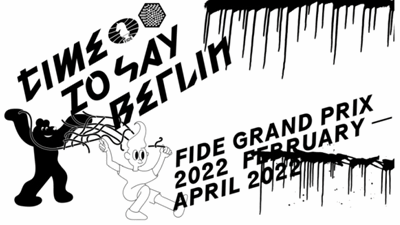To help with this, I added more detailed explanation to my page 2022 Grand Prix; Berlin, II-IV (m-w.com), and will continue with the crosstables as soon as I can. The second tournament of the Grand Prix will take place in Belgrade. [NB: The venue on that page for the series of three tournaments should read 'Berlin and Belgrade'.]
23 February 2022
2022 Grand Prix Regulations (cont.)
16 February 2022
C30 Zonal Qualification Paths
The record of the corresponding event, 2021 World Cup; Sochi (Russia), VII-VIII, 2021, reveals many discrepancies between players who qualified and players who participated. There were at least two reasons for this:-
- Complications from the coronavirus covid-19 pandemic.
- Enlargement of the event to include 90+ players nominated by national federations.
While documenting the previous cycle, C29 Zonal Qualification Paths (December 2019), I developed a chart comparing 'Qualified, but didn't play' vs. 'Played, but not on list of qualified players'. I'll do the same for C30.
09 February 2022
C30 More Zonal Clippings
The next step, of course, will be to flesh out the two stubs. I hope to tackle both at the same time.
Of course, of course, that was too ambitious. The clippings that I added to the primary page, Zonals 2020-2021, (C30; m-w.com), documented several events that had more complicated structures than zonals in past cycles. These were multi-stage hybrid events held online to decide qualifying players from continental federations. Will this online trend continue into the next cycle (C31)? We'll find out next year.
Worth mentioning is a blow-by-blow account by the Chessexpress blog of the event for zone 3.6. We first saw this blog two years ago in C29 Zonal Qualification Paths (December 2019). Here are the relevant posts:-
- 2021-03-04: 2021 Oceania Zonal • 'The 2021 Oceania Zonal is now going ahead as a "hybrid" event. This means that the players will be playing online, but supervised by an in place arbiter.'
- 2021-03-21: 2021 Oceania Zonal - Day 1
- 2021-03-22: On hybrid chess
- 2021-03-27: 2021 Oceania Zonal - Day 3
- 2021-03-28: Oceania Zonal - Final Day
Next step: tackle the page Zonal Qualifiers 2020-2021 (C30; m-w.com). Given the increase in the number of players, this also promises to be more complicated then previous pages of the same type.
02 February 2022
2022 Grand Prix & Candidates
- 2022 Grand Prix; Berlin, II-IV, 2022 (m-w.com)
- 2022 Candidates Tournament; Madrid, VI-VII, 2022 (ditto)
The Grand Prix starts in a few days and the Candidates Tournament, announced in December 2021, is a new page. The Grand Prix will qualify two players into the Candidates, which will decide the challenger for the next title match.
When I say, 'the Grand Prix starts in a few days', I'm not completely certain. On Monday, 31 January, FIDE annnounced, 'FIDE Grand Prix Series 2022 starts in Berlin on February 3', i.e. Thursday this week. A day later, on Tuesday, 1 February, the world federation announced, 'FIDE Grand Prix 2022: Ding and Andreikin replaced by Esipenko and Wojtaszek.' (See my 'Grand Prix' page for links to both annnouncements.)
Both Ding Liren and Dmitry Andreikin were on the list of players starting this week. Does FIDE's left hand not know what the right hand is doing? Did the federation not contact the players one last time before making the announcement?
Both of this week's annnouncements used the comic-style illustration shown below. On top of reminding me about those weird logos created for the 2018 World Championship, London (December 2017), I asked myself, 'What are those structures on the right side of the drawing?' The only explanation I could think of, besides Niagara Falls, was that they represent the Berlin Wall. That's OK if we're talking about chess; it's not OK if we're talking about Berlin as a 20th century political symbol.

There was one more surprise on the Monday announcement. Belgrade was listed as the venue for the second of the three Grand Prix events, where previously Berlin had been the announced venue for all three.
For the Candidates Tournament, there was also a surprise announcement: 'Candidates play-off introduced':-
The play-off will consist of rapid games. Details like the exact time control to be used and the total number of players to take part in the tie-break, will be decided in January after further consultation with players.
This would have been an issue for the 2013 Candidates Tournament, London (m-w.com), where Carlsen tied with Kramnik for first. As I documented on that page,
Carlsen was declared the winner based on 'b) The total number of wins'
Given Carlsen's expressed desire to cherry-pick his challenger -- see 2021 Carlsen - Nepomniachtchi, Wrapup (December 2021) for details -- a play-off match would allow the challengers to nudge Carlsen out of the title match. Has everyone thought these things through?
